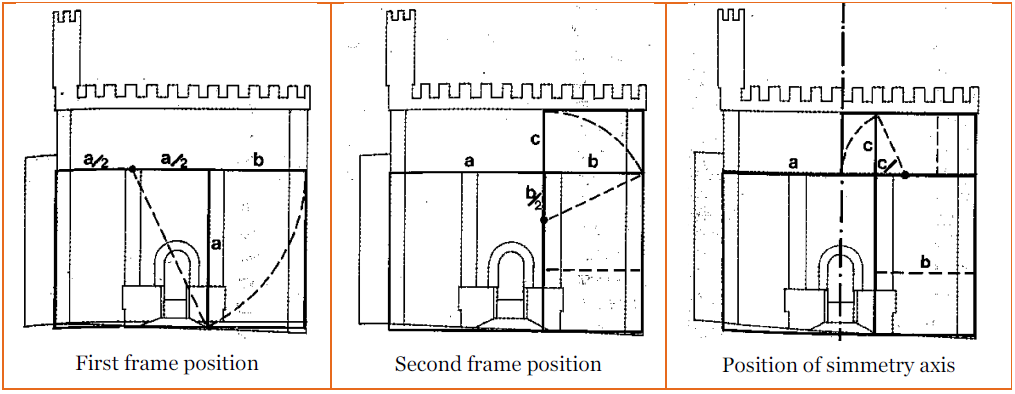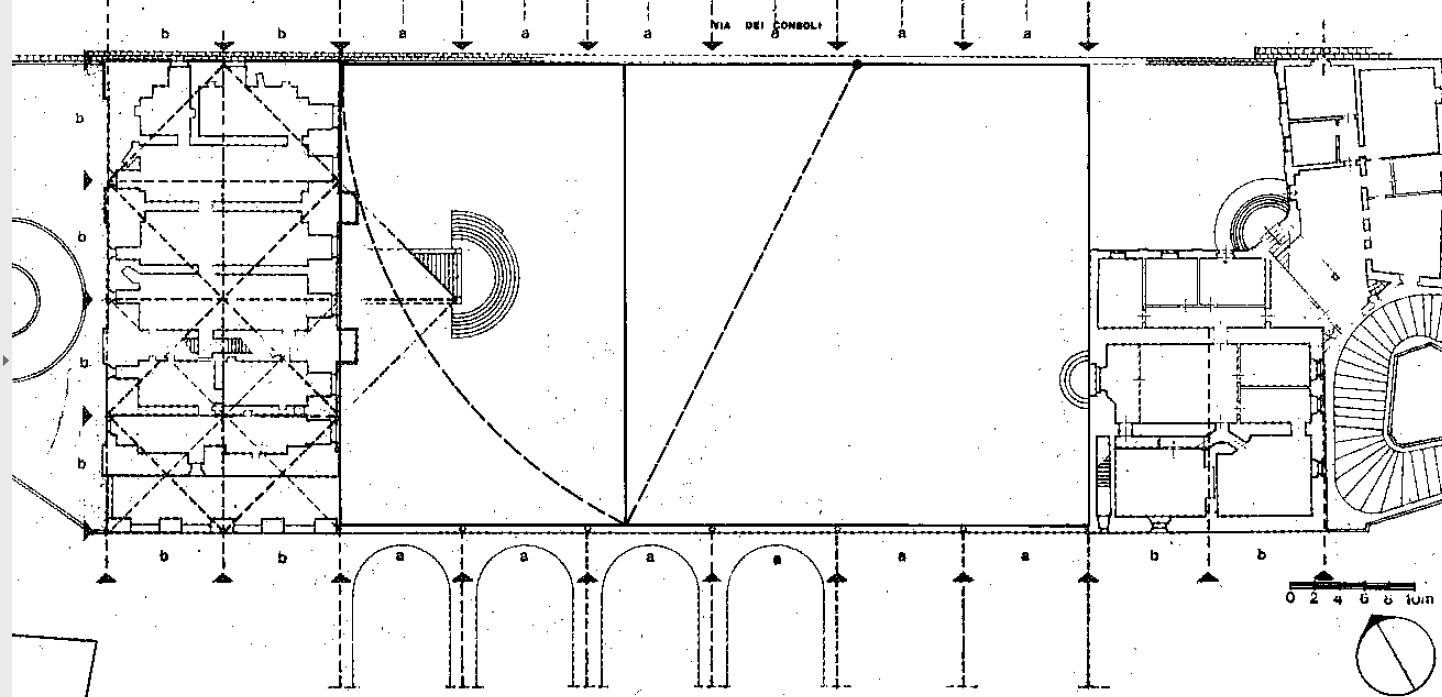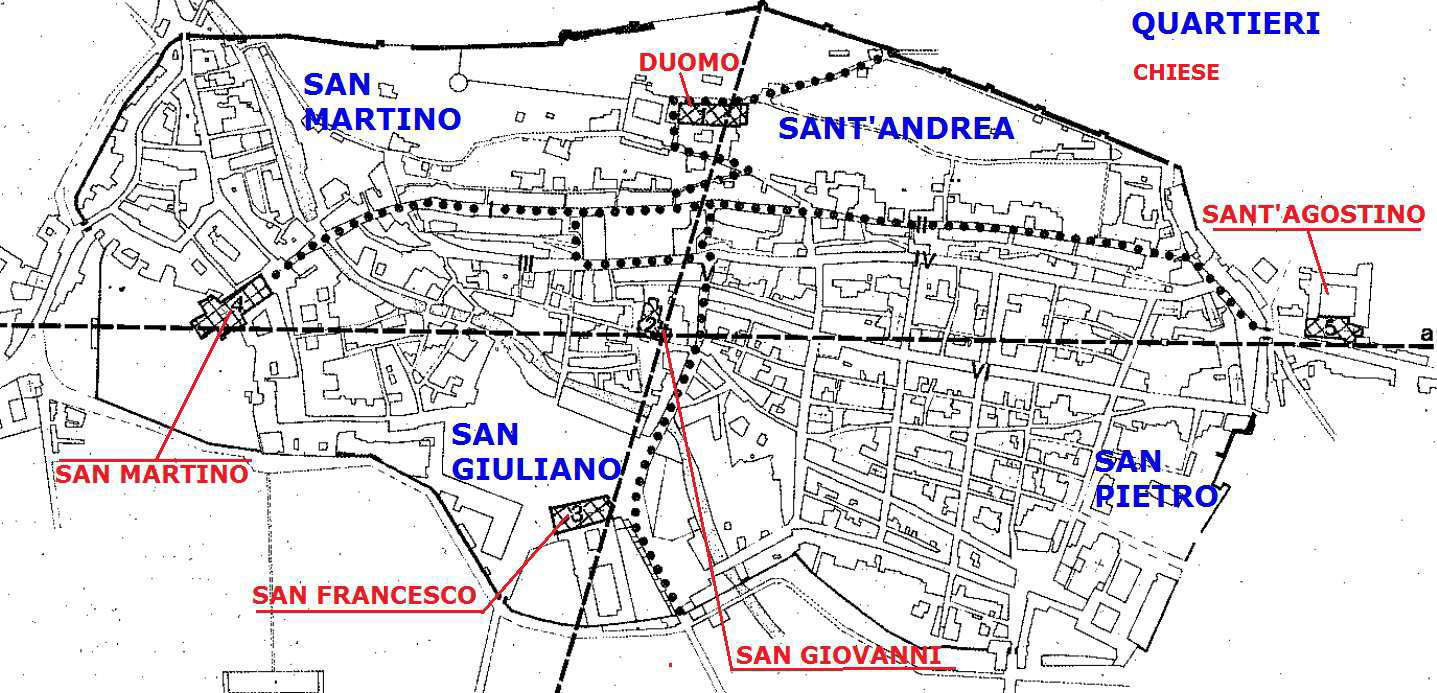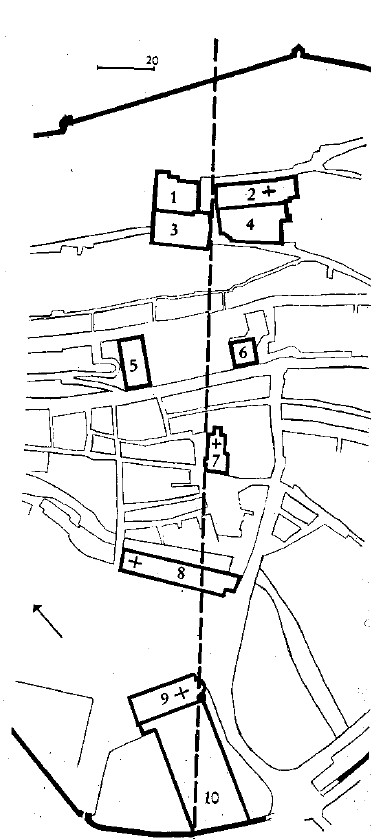
Construction details:
 The Consoli Palace was built between 1332 and 1349. The Palace has a rectangular shape, and a very
The Consoli Palace was built between 1332 and 1349. The Palace has a rectangular shape, and a very
articulated distribution of volumes divided into 9 levels:
· Level +6 (roof and tower bell)
· Level +5 (ex-kitchen, now “Campanari’shall in SW façade and Consoli’s chamber in NW façade )
· Level +4 (“noble” or main floor, the modern pinacotheque and upper open Lodge)
· Level +3 (upper closed Lodge – now Hall of “lustro” ceramics)
· Level +2 (Lower closed Lodge and chapel – now hall of Tavole Eugubine)
· Level +1 (the “Arengo”, a barrel vault hall which in Communal age was usedfor meetings and assembly of citizensfor the government of the city)
· Level 0 (“Capitano del Popolo” halls –now Risorgimento section)
· Level -1 (Lower entrance from Gattapone street – now museum)
· Level -2 (Halls in Baldassini street )
 The main façade overlooking the square is made of ashlar stone and it stands for over 44 meters up to thetop of bell tower. The entryway is through a fan-shaped staircase leading to the “Arengo” (level +1). This hall has two mullioned windows positioned on the two sides of the Gothic style portal, decorated with a XVI-century fresco in the lunette. In the main floor (level +4), there are six windows with round centre in pairs, divided by pillars, are present, while the battlements is supported by small pointed arches.
The main façade overlooking the square is made of ashlar stone and it stands for over 44 meters up to thetop of bell tower. The entryway is through a fan-shaped staircase leading to the “Arengo” (level +1). This hall has two mullioned windows positioned on the two sides of the Gothic style portal, decorated with a XVI-century fresco in the lunette. In the main floor (level +4), there are six windows with round centre in pairs, divided by pillars, are present, while the battlements is supported by small pointed arches.
Since 1901, the building hosts the town museum (see for more details: http://www.palazzodeiconsoli.it/), presenting art gallery, ceramics section, archaeological and oriental collection, and collection section on Italian Risorgimento (Risorgimento is the period leading to the unification of Italy) In the tower is placed the famous big bell (“campanone”) that since 1380 marks with its sound (sonate) very few and special events during the years.
Several restorations were made after the 1982 and 1984 earthquakes and completed in the first half of the ‘90s.
During these restorations, the façades were completely cleaned by accumulations of dirt. After few years, instead, smog, concretions and localized phenomena of black patina are again clearly visible.
Planimetry The first level (-2), in Baldassini Street (see picture 5), is mad by three rooms that were formerly used as warehouses or shops (since the presence of small windows and latrines).
The first level (-2), in Baldassini Street (see picture 5), is mad by three rooms that were formerly used as warehouses or shops (since the presence of small windows and latrines).
 The shape of the rooms in level -1 (picture 6),which opens towards NW on Gattapone Street,suggests an usage as dormitories and guarding stands and stables for horses (in the right ofpicture Picture 6) , while the other were probably a kitchen connected to a room of the Conestabile's availability. This level was strongly connected with the one upstairs at the square level so that the armed present had to be functionally dependent on the Captain of the People who was there..
The shape of the rooms in level -1 (picture 6),which opens towards NW on Gattapone Street,suggests an usage as dormitories and guarding stands and stables for horses (in the right ofpicture Picture 6) , while the other were probably a kitchen connected to a room of the Conestabile's availability. This level was strongly connected with the one upstairs at the square level so that the armed present had to be functionally dependent on the Captain of the People who was there..
 The zero level (picture 7) opens on Piazza Grande and on Consoli Street and its scheme consists of a series of rooms along the SE-NW alignment, all parallel to each other. All the rooms are surmounted by round arches and had latrines, one main entrance on the place made by doors of equal size and shape and one window opening on Gattapone street. The rooms are limited by the supporting walls of the Arengo Hall and one of them (the 4th from the left in the picture) is the retaining wall of the soil upstream placed in the "maximum advantage" position in order to separate the two levels of foundations (due to the original shape of soil). The walls on the West-side (in the left) have been deepened until level -2 while the others reach level -1 only
The zero level (picture 7) opens on Piazza Grande and on Consoli Street and its scheme consists of a series of rooms along the SE-NW alignment, all parallel to each other. All the rooms are surmounted by round arches and had latrines, one main entrance on the place made by doors of equal size and shape and one window opening on Gattapone street. The rooms are limited by the supporting walls of the Arengo Hall and one of them (the 4th from the left in the picture) is the retaining wall of the soil upstream placed in the "maximum advantage" position in order to separate the two levels of foundations (due to the original shape of soil). The walls on the West-side (in the left) have been deepened until level -2 while the others reach level -1 only
 The Arengo Hall (picture 8) was the meeting place of the General Council of the People. Anyone who comes in is astonished by the majesty of the all-round vault overlooking covering over 730 square meters. The room is connected with the upper “noble” floor and the loggias on the W side. Curiously is to be noted the presence of an external toilet placed in the N side of the hall (in upeer right side of the picture above) in order not to let the
The Arengo Hall (picture 8) was the meeting place of the General Council of the People. Anyone who comes in is astonished by the majesty of the all-round vault overlooking covering over 730 square meters. The room is connected with the upper “noble” floor and the loggias on the W side. Curiously is to be noted the presence of an external toilet placed in the N side of the hall (in upeer right side of the picture above) in order not to let the
stink to disturb the hundreds of people attending the Council meetings.
 At level +3 ("noble" or main floor –picture 9) there are the halls dedicated to the functions of the Gonfalonier and the Consuls. More than half of the total space is devoted to the large central hall.This was the space of the Authority with the emblematic elements of two fountains in the hall. The biggest one has an octagonal basin placed to be Visible by any host or citizen climbing the last steps of the staircase, in order to surprise them. In an age during which the water supply was guaranteed by few public springs, it should have been simply astonishing finding a fountain inside a room 20 meters above the ground.
At level +3 ("noble" or main floor –picture 9) there are the halls dedicated to the functions of the Gonfalonier and the Consuls. More than half of the total space is devoted to the large central hall.This was the space of the Authority with the emblematic elements of two fountains in the hall. The biggest one has an octagonal basin placed to be Visible by any host or citizen climbing the last steps of the staircase, in order to surprise them. In an age during which the water supply was guaranteed by few public springs, it should have been simply astonishing finding a fountain inside a room 20 meters above the ground.
 All the places of this plan and the upper one, with the former kitchen and the Chamber of Consuls, is made for the strictly requirement to let the Consoli live in absolute isolation during the two months of their mandate without no relationships with citizens or strangers.
All the places of this plan and the upper one, with the former kitchen and the Chamber of Consuls, is made for the strictly requirement to let the Consoli live in absolute isolation during the two months of their mandate without no relationships with citizens or strangers.
The architectural proportions
The volumes of the two buildings were conceived as an unique complex and complementary to the
interposed vacuum consisting by the place. Infact, the facades and the plans can be both inscribed in a single rectangular perimeter and form a prism with 4 equal faces organized according to a precise modular logic.

The facade of the Consoli Palace is divided by a series of sketches and frames that clearly define
horizontal and vertical scans.It can be verified that the determination of the facade dimensions and proportions is based on the “golden rectangle”, a geometric figure whose proportional laws were always appreciated in classical antiquity and rediscovered in the late Middle Ages to laterspread to the Renaissance. The proportionality criterion for the square, the Consoli Palace and the actual City Hall is also based on a
“golden rectangle” proportions whose lower side coincides with the façade of the Consoli Palace. Also
Picture 12 - Consoli Palace, Town Hall (former Podestà palace) and "Platea Communis": Reconstructive
plan and proportional schemes the proportion of the entire complex is based on many “golden rectangles” whose concatenation establishes strict relations between the big and the small scale.

A brief history of the palace
 In Gubbio, as in the major manufacturing centers of Central Italy, from the end of 1200 to 1370, the middle class gradually replaced the landowners in the city's government. A demographic growth phenomenon occurred, leading to a downward expansion of the urban core with the reoccupation of the outer town walls spaces and new built areas. This was due to the rise of the middle class of craftsmen who set themselves up between nobles (traders) and landowners.
In Gubbio, as in the major manufacturing centers of Central Italy, from the end of 1200 to 1370, the middle class gradually replaced the landowners in the city's government. A demographic growth phenomenon occurred, leading to a downward expansion of the urban core with the reoccupation of the outer town walls spaces and new built areas. This was due to the rise of the middle class of craftsmen who set themselves up between nobles (traders) and landowners.
 This demographic expansion of the popular classes led to the achievement of a new urban shape underlined both by the reconstruction of the main churches and by the completion of the new Town wall circuit. The city from first medieval age since then was divided into the "High Town", raised above the so-called "trench" (now identifiable in the crag that separated the modern via Baldassini from Piazza Grande) and "Lower Town" (the new one raised downstream), but this project should give them an unique entity. The traditional division of Gubbio into 7 "vici" (see picture 13) became division into four districts (see picture 14) still today existing: Sant'Andrea, San Pietro, San Giuliano and San Martino. Each of them was quadrant of the "crux ecclesialis" (see picture 14) defined by the axes connecting the Duomo with the churches of the three begging orders, with of the ancient Pieve of St. John in the center. The historian Enrico Guidoni in 1974 theorized that this "crux ecclesialis" was part (at the town level) of a very ancient Umbrian alignment that linked the ends of the possessions of the Commune of Gubbio (the town of Pergola) and the Castle of Castiglione Aldobrando, see picture 15 and 16).
This demographic expansion of the popular classes led to the achievement of a new urban shape underlined both by the reconstruction of the main churches and by the completion of the new Town wall circuit. The city from first medieval age since then was divided into the "High Town", raised above the so-called "trench" (now identifiable in the crag that separated the modern via Baldassini from Piazza Grande) and "Lower Town" (the new one raised downstream), but this project should give them an unique entity. The traditional division of Gubbio into 7 "vici" (see picture 13) became division into four districts (see picture 14) still today existing: Sant'Andrea, San Pietro, San Giuliano and San Martino. Each of them was quadrant of the "crux ecclesialis" (see picture 14) defined by the axes connecting the Duomo with the churches of the three begging orders, with of the ancient Pieve of St. John in the center. The historian Enrico Guidoni in 1974 theorized that this "crux ecclesialis" was part (at the town level) of a very ancient Umbrian alignment that linked the ends of the possessions of the Commune of Gubbio (the town of Pergola) and the Castle of Castiglione Aldobrando, see picture 15 and 16).
 1 - corte (fino XII
1 - corte (fino XII
secolo) + 3 – Antico
Palazzo Comunale
(ora Palazzo Ducale)
2 – Duomo
4- palazzo del capitolo
These 4 buildings were
the political centre of
the city until XII cent.
5 – Consoli Palace
6 – Town Hall
(built since XIV cent.)
7 – San Giovanni
8 – Logge dei Tiratoi
9 – San Francesco
Upstream St. John’s Church (San Giovanni - the first Cathedral) there was the division between hilly and valley districts, a zone characterized by a steep slope (the "trench"). During the first half of the XIV century, in the half way of this alignment, the free Commune of Gubbio designed and realized the wonderful new complex made up of public buildings and the Great “Piazza Grande”.
The aim was to create a new administrative political center that took into account the changed urban shape of the city in order to be tangent to all the 4 districts. The new municipal buildings were therefore positioned in order to overcome the “trench” and to have a tower-shape from the underlying streets, emphasized by the use of the natural slope.
In 1321 was stated the building of the “Palazzo del Popolo” (now the Consoli Palace), the “Podestà Palace” (now the Town Hall” and the”Platea Communis” (now Piazza Grande). It was a large-scale enterprise with the aim to show the will of the Commune to impose the new city center as a major reference for all the territory. That’s why it is clearly visible from every place of the town and the surrounding valley: a warning and sanction of the supremacy of the municipal government on every other authority. The building started in 1332, at the end of the fund raising .
After only 5 years the architrave of the major portal was put in place and in 1349 the covering was completed even if with a different shape from the current one.
 The fountain in the noble plan had a particular meaning, both technical and symbolic. On one side the fountain showed the technological advanced position of the city, on the other side the fountain symbolized the "fons arenghi", the ancient fountain who was in the old city center, in front of the Cathedral, in order to state, the definitive moving of the political core of the city to the new Consoli Palace.
The fountain in the noble plan had a particular meaning, both technical and symbolic. On one side the fountain showed the technological advanced position of the city, on the other side the fountain symbolized the "fons arenghi", the ancient fountain who was in the old city center, in front of the Cathedral, in order to state, the definitive moving of the political core of the city to the new Consoli Palace.
 It is supposed that the original project provided a major place for the commerce and meetings, the Consoli (or "People" palace) in the N-W side of the place and the Podestà Palace set in SE side. All the citizens from the four quartier should access the place through an own way. There were two streets connecting the place from est and west (from the actual Consoli street and XX september street) to San Martino and Saint Andrea districts. Furthermore, according to the historian O. Gurrieri and Arch P. Belardi, the original project should have two steep ramps, one for the San Giuliano district through the gallery under the Consoli Palace and the other placed symmetrically respect to the first, connecting Piazza Grande with the district of San Pietro. These last two access ways were never built and in the following centuries that access was ensured through other bandy streets. The building operations were interrupted leaving the place built only partially. This was due to the end of the Free Commune experience provided by the 1350 “golpe” made by Giovanni Gabrielli and the Bubonic Plague.
It is supposed that the original project provided a major place for the commerce and meetings, the Consoli (or "People" palace) in the N-W side of the place and the Podestà Palace set in SE side. All the citizens from the four quartier should access the place through an own way. There were two streets connecting the place from est and west (from the actual Consoli street and XX september street) to San Martino and Saint Andrea districts. Furthermore, according to the historian O. Gurrieri and Arch P. Belardi, the original project should have two steep ramps, one for the San Giuliano district through the gallery under the Consoli Palace and the other placed symmetrically respect to the first, connecting Piazza Grande with the district of San Pietro. These last two access ways were never built and in the following centuries that access was ensured through other bandy streets. The building operations were interrupted leaving the place built only partially. This was due to the end of the Free Commune experience provided by the 1350 “golpe” made by Giovanni Gabrielli and the Bubonic Plague.
 In 1491 the steep ramp connecting Baldassini street through the inclined gallery of the Consoli Palace was started in order to be the organic conclusion of the complex but the opera failed. This was this the end of a too ambitious project that had lost the conditions for its start. At the beginning of the 15th century, the Consoli Palace was completed with the tower bell and the place was finally completed with the “loggia” connecting the Consoli Palace with the Town Hall which was demolished at end of XIX century. The current Town Hall had several intervention and the last one, the building of the North wing, was made at the end of XIX century. From XV until XIX centuries there were many attempts to complete the complex of buildings, but none of them was able to define completely and stabily the place-palaces unity which is still today unfinished
In 1491 the steep ramp connecting Baldassini street through the inclined gallery of the Consoli Palace was started in order to be the organic conclusion of the complex but the opera failed. This was this the end of a too ambitious project that had lost the conditions for its start. At the beginning of the 15th century, the Consoli Palace was completed with the tower bell and the place was finally completed with the “loggia” connecting the Consoli Palace with the Town Hall which was demolished at end of XIX century. The current Town Hall had several intervention and the last one, the building of the North wing, was made at the end of XIX century. From XV until XIX centuries there were many attempts to complete the complex of buildings, but none of them was able to define completely and stabily the place-palaces unity which is still today unfinished



